Ethics, Values and Corporate Governance -
VerifiedAdded on 2022/09/01
|15
|4034
|21
AI Summary
Contribute Materials
Your contribution can guide someone’s learning journey. Share your
documents today.
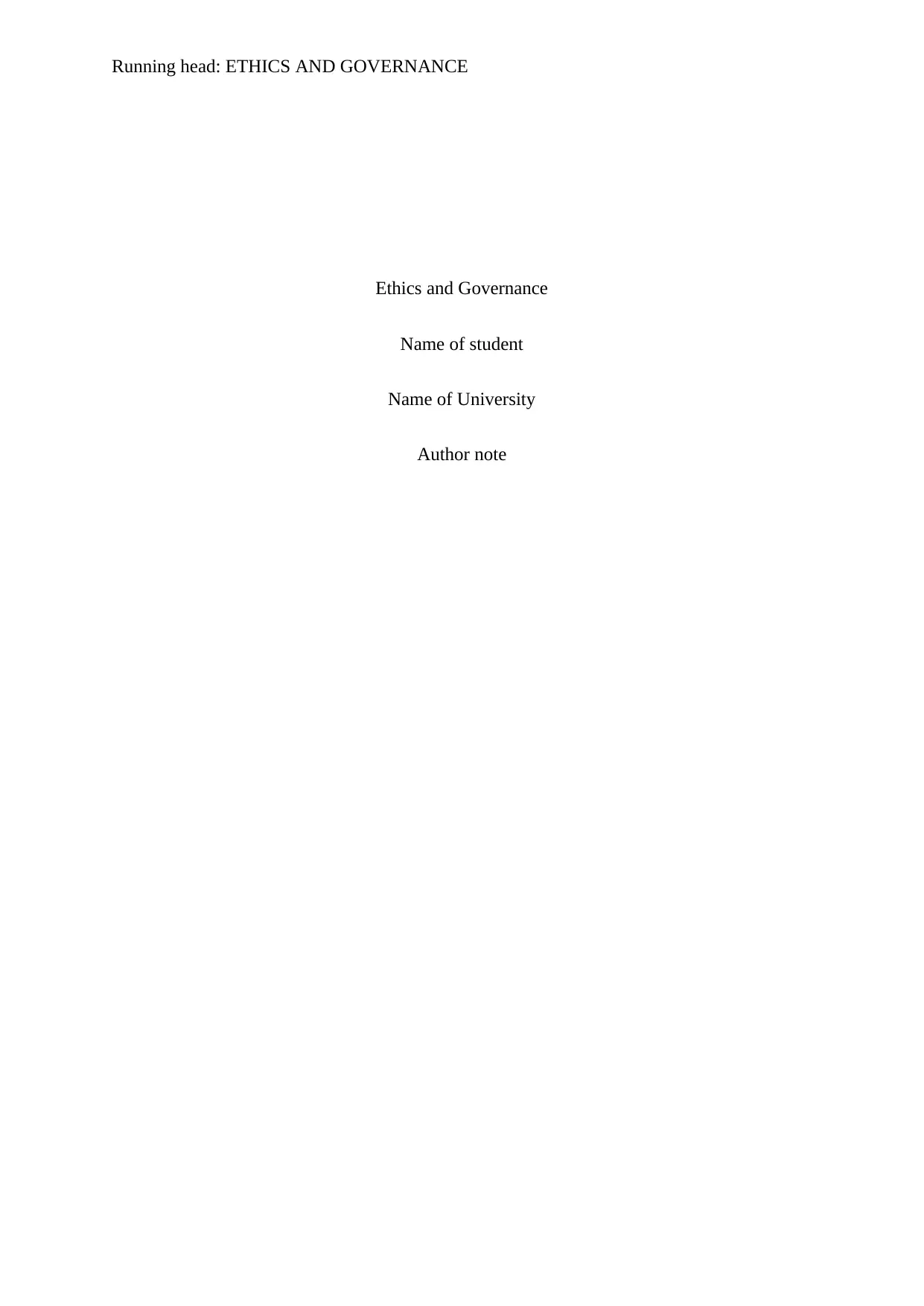
Running head: ETHICS AND GOVERNANCE
Ethics and Governance
Name of student
Name of University
Author note
Ethics and Governance
Name of student
Name of University
Author note
Secure Best Marks with AI Grader
Need help grading? Try our AI Grader for instant feedback on your assignments.
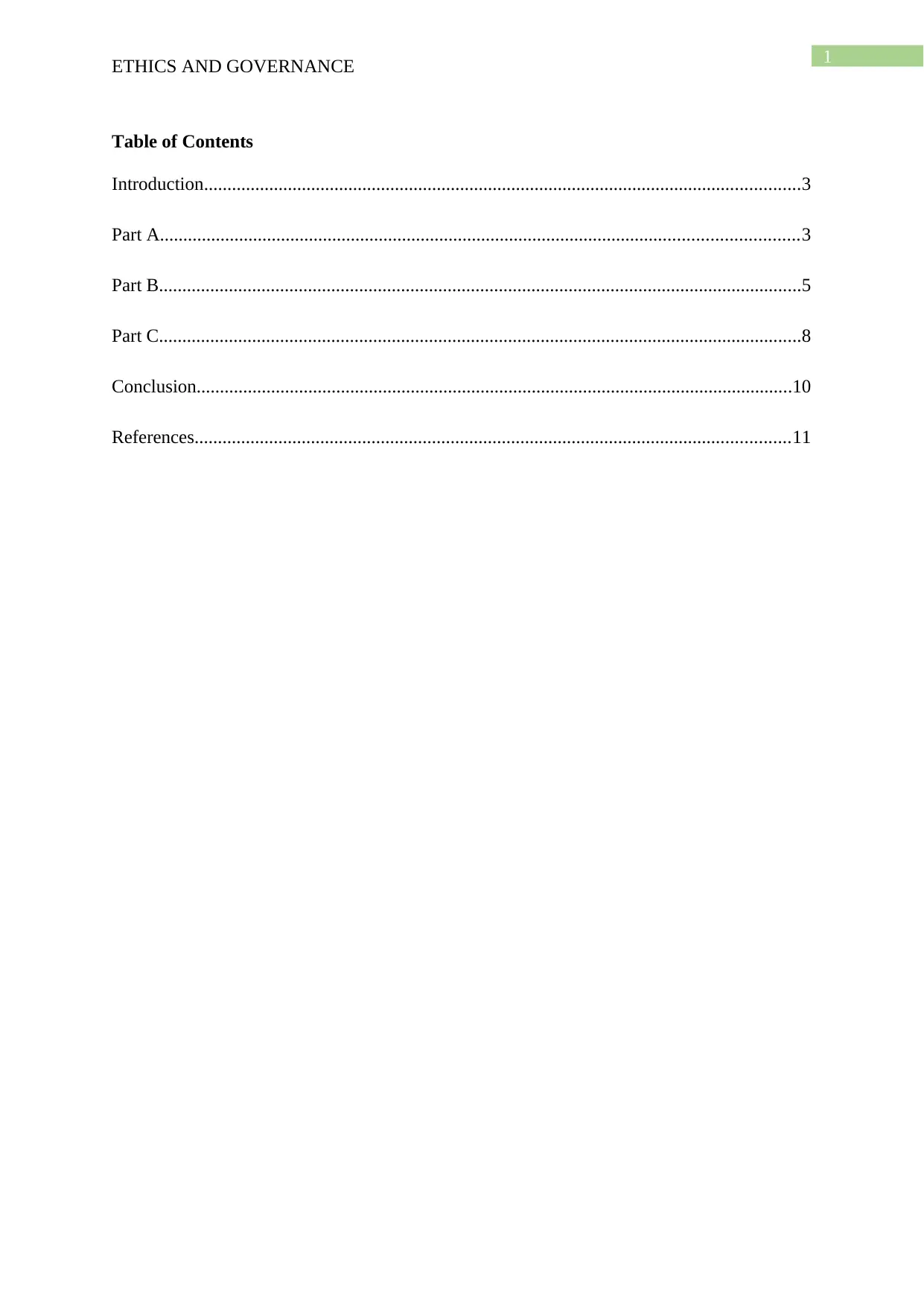
1
ETHICS AND GOVERNANCE
Table of Contents
Introduction................................................................................................................................3
Part A.........................................................................................................................................3
Part B..........................................................................................................................................5
Part C..........................................................................................................................................8
Conclusion................................................................................................................................10
References................................................................................................................................11
ETHICS AND GOVERNANCE
Table of Contents
Introduction................................................................................................................................3
Part A.........................................................................................................................................3
Part B..........................................................................................................................................5
Part C..........................................................................................................................................8
Conclusion................................................................................................................................10
References................................................................................................................................11
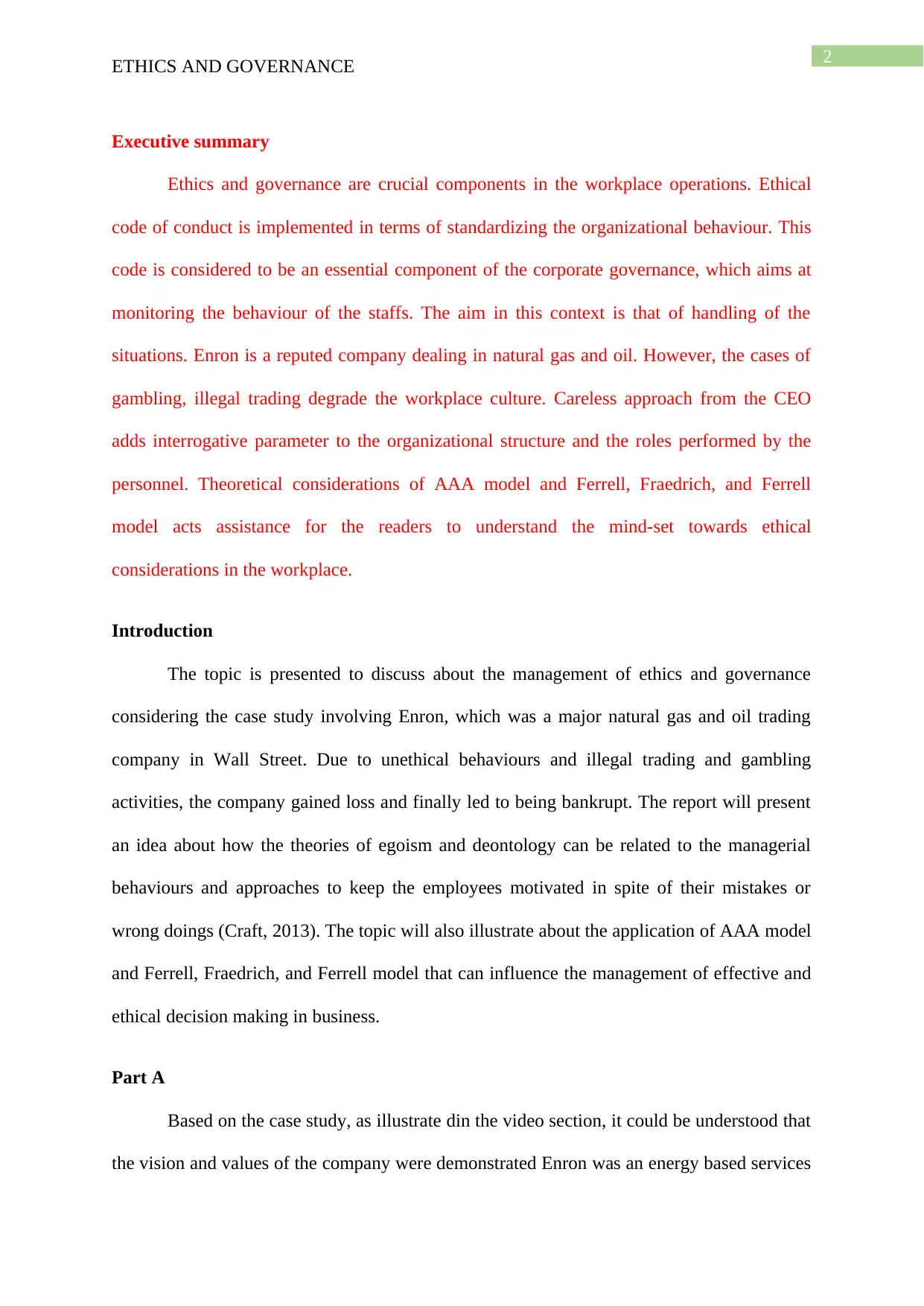
2
ETHICS AND GOVERNANCE
Executive summary
Ethics and governance are crucial components in the workplace operations. Ethical
code of conduct is implemented in terms of standardizing the organizational behaviour. This
code is considered to be an essential component of the corporate governance, which aims at
monitoring the behaviour of the staffs. The aim in this context is that of handling of the
situations. Enron is a reputed company dealing in natural gas and oil. However, the cases of
gambling, illegal trading degrade the workplace culture. Careless approach from the CEO
adds interrogative parameter to the organizational structure and the roles performed by the
personnel. Theoretical considerations of AAA model and Ferrell, Fraedrich, and Ferrell
model acts assistance for the readers to understand the mind-set towards ethical
considerations in the workplace.
Introduction
The topic is presented to discuss about the management of ethics and governance
considering the case study involving Enron, which was a major natural gas and oil trading
company in Wall Street. Due to unethical behaviours and illegal trading and gambling
activities, the company gained loss and finally led to being bankrupt. The report will present
an idea about how the theories of egoism and deontology can be related to the managerial
behaviours and approaches to keep the employees motivated in spite of their mistakes or
wrong doings (Craft, 2013). The topic will also illustrate about the application of AAA model
and Ferrell, Fraedrich, and Ferrell model that can influence the management of effective and
ethical decision making in business.
Part A
Based on the case study, as illustrate din the video section, it could be understood that
the vision and values of the company were demonstrated Enron was an energy based services
ETHICS AND GOVERNANCE
Executive summary
Ethics and governance are crucial components in the workplace operations. Ethical
code of conduct is implemented in terms of standardizing the organizational behaviour. This
code is considered to be an essential component of the corporate governance, which aims at
monitoring the behaviour of the staffs. The aim in this context is that of handling of the
situations. Enron is a reputed company dealing in natural gas and oil. However, the cases of
gambling, illegal trading degrade the workplace culture. Careless approach from the CEO
adds interrogative parameter to the organizational structure and the roles performed by the
personnel. Theoretical considerations of AAA model and Ferrell, Fraedrich, and Ferrell
model acts assistance for the readers to understand the mind-set towards ethical
considerations in the workplace.
Introduction
The topic is presented to discuss about the management of ethics and governance
considering the case study involving Enron, which was a major natural gas and oil trading
company in Wall Street. Due to unethical behaviours and illegal trading and gambling
activities, the company gained loss and finally led to being bankrupt. The report will present
an idea about how the theories of egoism and deontology can be related to the managerial
behaviours and approaches to keep the employees motivated in spite of their mistakes or
wrong doings (Craft, 2013). The topic will also illustrate about the application of AAA model
and Ferrell, Fraedrich, and Ferrell model that can influence the management of effective and
ethical decision making in business.
Part A
Based on the case study, as illustrate din the video section, it could be understood that
the vision and values of the company were demonstrated Enron was an energy based services
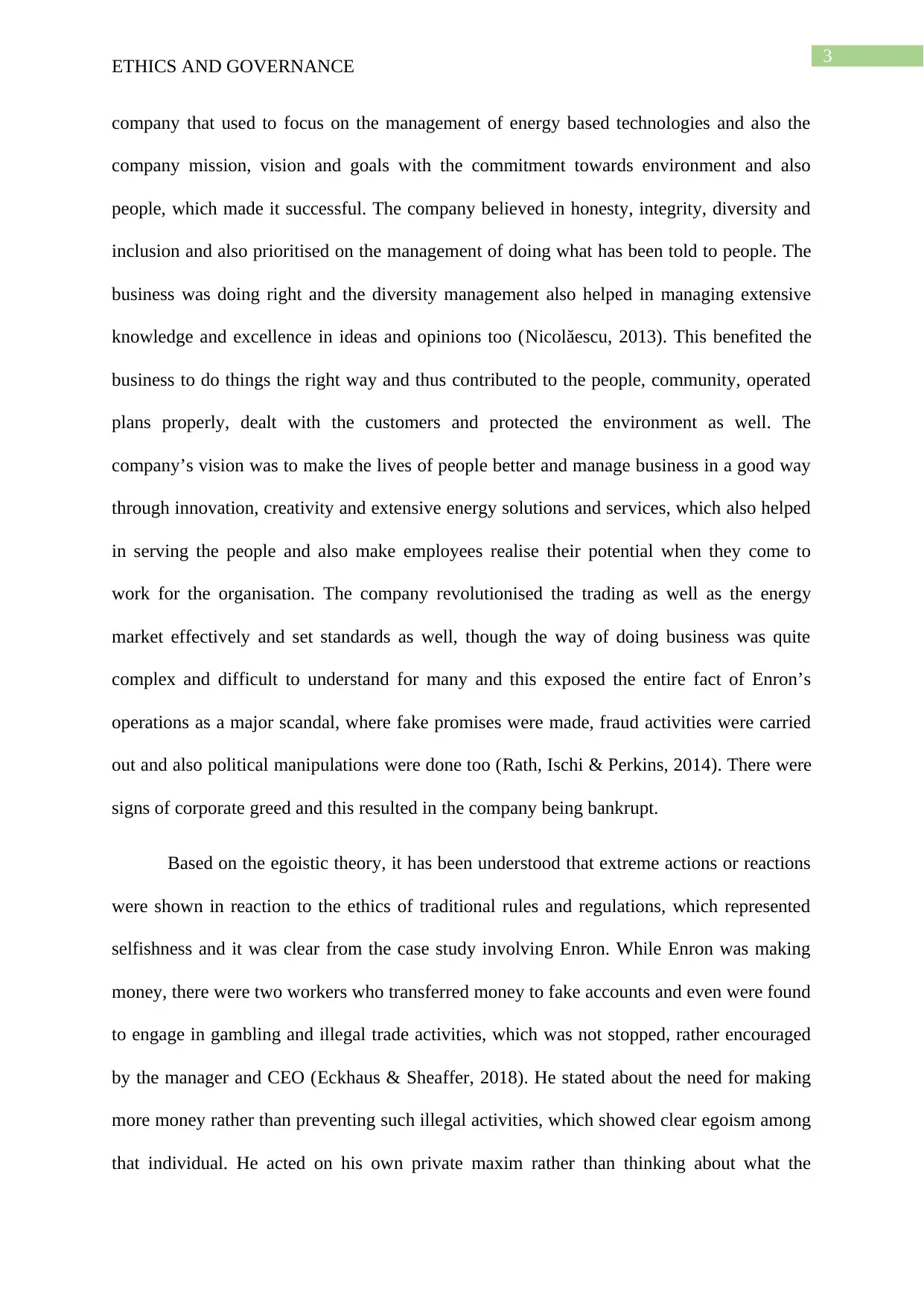
3
ETHICS AND GOVERNANCE
company that used to focus on the management of energy based technologies and also the
company mission, vision and goals with the commitment towards environment and also
people, which made it successful. The company believed in honesty, integrity, diversity and
inclusion and also prioritised on the management of doing what has been told to people. The
business was doing right and the diversity management also helped in managing extensive
knowledge and excellence in ideas and opinions too (Nicolăescu, 2013). This benefited the
business to do things the right way and thus contributed to the people, community, operated
plans properly, dealt with the customers and protected the environment as well. The
company’s vision was to make the lives of people better and manage business in a good way
through innovation, creativity and extensive energy solutions and services, which also helped
in serving the people and also make employees realise their potential when they come to
work for the organisation. The company revolutionised the trading as well as the energy
market effectively and set standards as well, though the way of doing business was quite
complex and difficult to understand for many and this exposed the entire fact of Enron’s
operations as a major scandal, where fake promises were made, fraud activities were carried
out and also political manipulations were done too (Rath, Ischi & Perkins, 2014). There were
signs of corporate greed and this resulted in the company being bankrupt.
Based on the egoistic theory, it has been understood that extreme actions or reactions
were shown in reaction to the ethics of traditional rules and regulations, which represented
selfishness and it was clear from the case study involving Enron. While Enron was making
money, there were two workers who transferred money to fake accounts and even were found
to engage in gambling and illegal trade activities, which was not stopped, rather encouraged
by the manager and CEO (Eckhaus & Sheaffer, 2018). He stated about the need for making
more money rather than preventing such illegal activities, which showed clear egoism among
that individual. He acted on his own private maxim rather than thinking about what the
ETHICS AND GOVERNANCE
company that used to focus on the management of energy based technologies and also the
company mission, vision and goals with the commitment towards environment and also
people, which made it successful. The company believed in honesty, integrity, diversity and
inclusion and also prioritised on the management of doing what has been told to people. The
business was doing right and the diversity management also helped in managing extensive
knowledge and excellence in ideas and opinions too (Nicolăescu, 2013). This benefited the
business to do things the right way and thus contributed to the people, community, operated
plans properly, dealt with the customers and protected the environment as well. The
company’s vision was to make the lives of people better and manage business in a good way
through innovation, creativity and extensive energy solutions and services, which also helped
in serving the people and also make employees realise their potential when they come to
work for the organisation. The company revolutionised the trading as well as the energy
market effectively and set standards as well, though the way of doing business was quite
complex and difficult to understand for many and this exposed the entire fact of Enron’s
operations as a major scandal, where fake promises were made, fraud activities were carried
out and also political manipulations were done too (Rath, Ischi & Perkins, 2014). There were
signs of corporate greed and this resulted in the company being bankrupt.
Based on the egoistic theory, it has been understood that extreme actions or reactions
were shown in reaction to the ethics of traditional rules and regulations, which represented
selfishness and it was clear from the case study involving Enron. While Enron was making
money, there were two workers who transferred money to fake accounts and even were found
to engage in gambling and illegal trade activities, which was not stopped, rather encouraged
by the manager and CEO (Eckhaus & Sheaffer, 2018). He stated about the need for making
more money rather than preventing such illegal activities, which showed clear egoism among
that individual. He acted on his own private maxim rather than thinking about what the
Secure Best Marks with AI Grader
Need help grading? Try our AI Grader for instant feedback on your assignments.
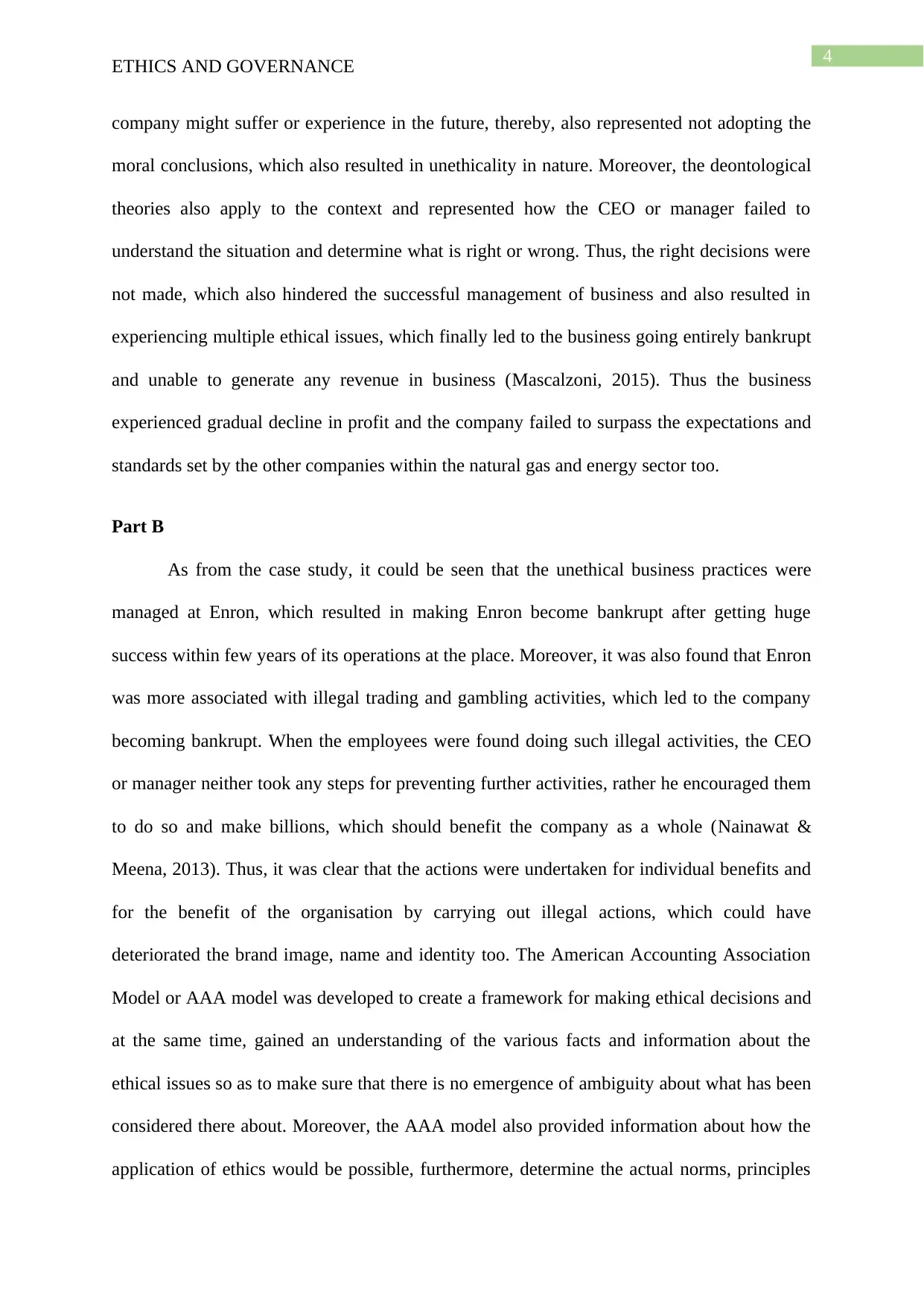
4
ETHICS AND GOVERNANCE
company might suffer or experience in the future, thereby, also represented not adopting the
moral conclusions, which also resulted in unethicality in nature. Moreover, the deontological
theories also apply to the context and represented how the CEO or manager failed to
understand the situation and determine what is right or wrong. Thus, the right decisions were
not made, which also hindered the successful management of business and also resulted in
experiencing multiple ethical issues, which finally led to the business going entirely bankrupt
and unable to generate any revenue in business (Mascalzoni, 2015). Thus the business
experienced gradual decline in profit and the company failed to surpass the expectations and
standards set by the other companies within the natural gas and energy sector too.
Part B
As from the case study, it could be seen that the unethical business practices were
managed at Enron, which resulted in making Enron become bankrupt after getting huge
success within few years of its operations at the place. Moreover, it was also found that Enron
was more associated with illegal trading and gambling activities, which led to the company
becoming bankrupt. When the employees were found doing such illegal activities, the CEO
or manager neither took any steps for preventing further activities, rather he encouraged them
to do so and make billions, which should benefit the company as a whole (Nainawat &
Meena, 2013). Thus, it was clear that the actions were undertaken for individual benefits and
for the benefit of the organisation by carrying out illegal actions, which could have
deteriorated the brand image, name and identity too. The American Accounting Association
Model or AAA model was developed to create a framework for making ethical decisions and
at the same time, gained an understanding of the various facts and information about the
ethical issues so as to make sure that there is no emergence of ambiguity about what has been
considered there about. Moreover, the AAA model also provided information about how the
application of ethics would be possible, furthermore, determine the actual norms, principles
ETHICS AND GOVERNANCE
company might suffer or experience in the future, thereby, also represented not adopting the
moral conclusions, which also resulted in unethicality in nature. Moreover, the deontological
theories also apply to the context and represented how the CEO or manager failed to
understand the situation and determine what is right or wrong. Thus, the right decisions were
not made, which also hindered the successful management of business and also resulted in
experiencing multiple ethical issues, which finally led to the business going entirely bankrupt
and unable to generate any revenue in business (Mascalzoni, 2015). Thus the business
experienced gradual decline in profit and the company failed to surpass the expectations and
standards set by the other companies within the natural gas and energy sector too.
Part B
As from the case study, it could be seen that the unethical business practices were
managed at Enron, which resulted in making Enron become bankrupt after getting huge
success within few years of its operations at the place. Moreover, it was also found that Enron
was more associated with illegal trading and gambling activities, which led to the company
becoming bankrupt. When the employees were found doing such illegal activities, the CEO
or manager neither took any steps for preventing further activities, rather he encouraged them
to do so and make billions, which should benefit the company as a whole (Nainawat &
Meena, 2013). Thus, it was clear that the actions were undertaken for individual benefits and
for the benefit of the organisation by carrying out illegal actions, which could have
deteriorated the brand image, name and identity too. The American Accounting Association
Model or AAA model was developed to create a framework for making ethical decisions and
at the same time, gained an understanding of the various facts and information about the
ethical issues so as to make sure that there is no emergence of ambiguity about what has been
considered there about. Moreover, the AAA model also provided information about how the
application of ethics would be possible, furthermore, determine the actual norms, principles
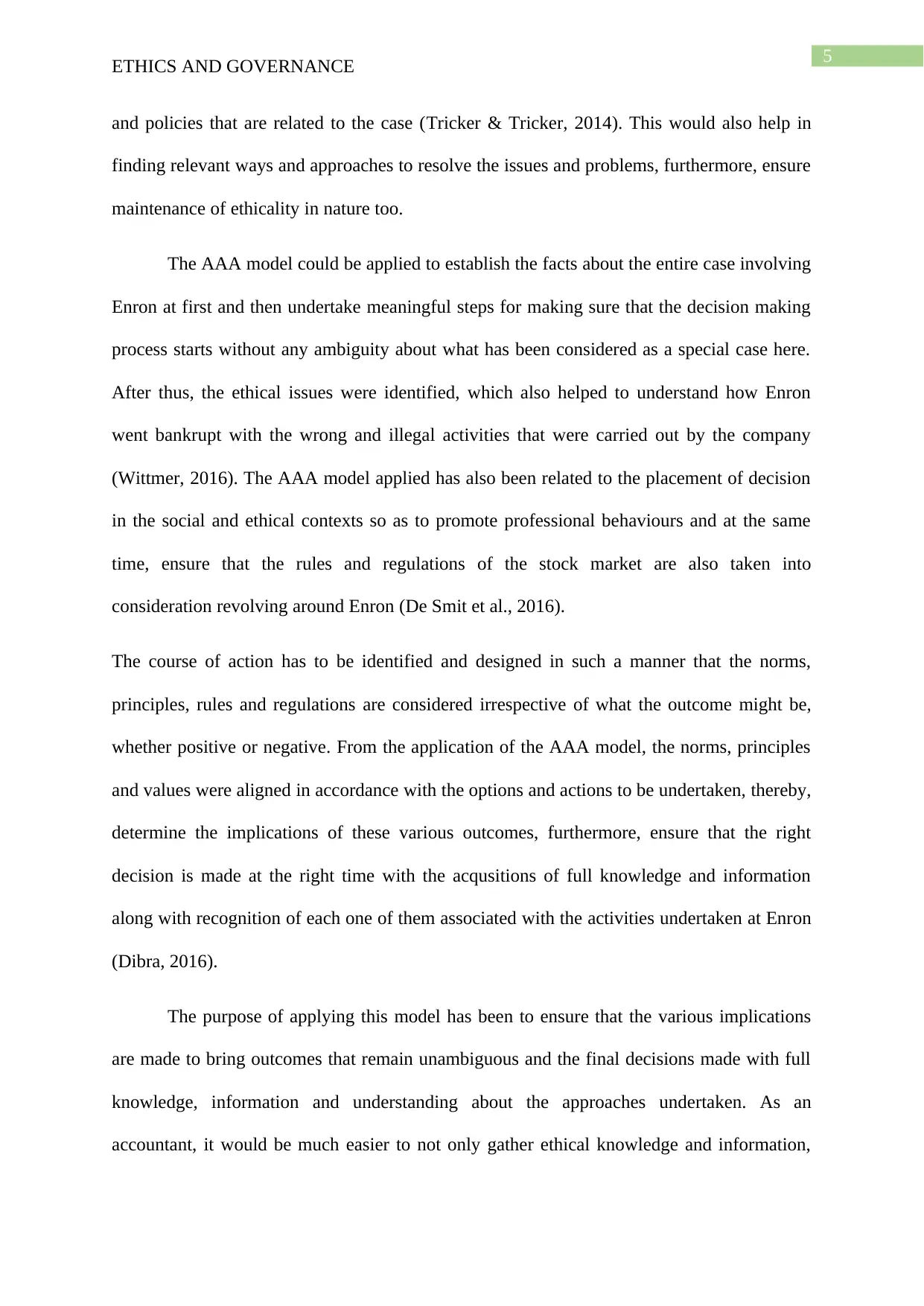
5
ETHICS AND GOVERNANCE
and policies that are related to the case (Tricker & Tricker, 2014). This would also help in
finding relevant ways and approaches to resolve the issues and problems, furthermore, ensure
maintenance of ethicality in nature too.
The AAA model could be applied to establish the facts about the entire case involving
Enron at first and then undertake meaningful steps for making sure that the decision making
process starts without any ambiguity about what has been considered as a special case here.
After thus, the ethical issues were identified, which also helped to understand how Enron
went bankrupt with the wrong and illegal activities that were carried out by the company
(Wittmer, 2016). The AAA model applied has also been related to the placement of decision
in the social and ethical contexts so as to promote professional behaviours and at the same
time, ensure that the rules and regulations of the stock market are also taken into
consideration revolving around Enron (De Smit et al., 2016).
The course of action has to be identified and designed in such a manner that the norms,
principles, rules and regulations are considered irrespective of what the outcome might be,
whether positive or negative. From the application of the AAA model, the norms, principles
and values were aligned in accordance with the options and actions to be undertaken, thereby,
determine the implications of these various outcomes, furthermore, ensure that the right
decision is made at the right time with the acqusitions of full knowledge and information
along with recognition of each one of them associated with the activities undertaken at Enron
(Dibra, 2016).
The purpose of applying this model has been to ensure that the various implications
are made to bring outcomes that remain unambiguous and the final decisions made with full
knowledge, information and understanding about the approaches undertaken. As an
accountant, it would be much easier to not only gather ethical knowledge and information,
ETHICS AND GOVERNANCE
and policies that are related to the case (Tricker & Tricker, 2014). This would also help in
finding relevant ways and approaches to resolve the issues and problems, furthermore, ensure
maintenance of ethicality in nature too.
The AAA model could be applied to establish the facts about the entire case involving
Enron at first and then undertake meaningful steps for making sure that the decision making
process starts without any ambiguity about what has been considered as a special case here.
After thus, the ethical issues were identified, which also helped to understand how Enron
went bankrupt with the wrong and illegal activities that were carried out by the company
(Wittmer, 2016). The AAA model applied has also been related to the placement of decision
in the social and ethical contexts so as to promote professional behaviours and at the same
time, ensure that the rules and regulations of the stock market are also taken into
consideration revolving around Enron (De Smit et al., 2016).
The course of action has to be identified and designed in such a manner that the norms,
principles, rules and regulations are considered irrespective of what the outcome might be,
whether positive or negative. From the application of the AAA model, the norms, principles
and values were aligned in accordance with the options and actions to be undertaken, thereby,
determine the implications of these various outcomes, furthermore, ensure that the right
decision is made at the right time with the acqusitions of full knowledge and information
along with recognition of each one of them associated with the activities undertaken at Enron
(Dibra, 2016).
The purpose of applying this model has been to ensure that the various implications
are made to bring outcomes that remain unambiguous and the final decisions made with full
knowledge, information and understanding about the approaches undertaken. As an
accountant, it would be much easier to not only gather ethical knowledge and information,
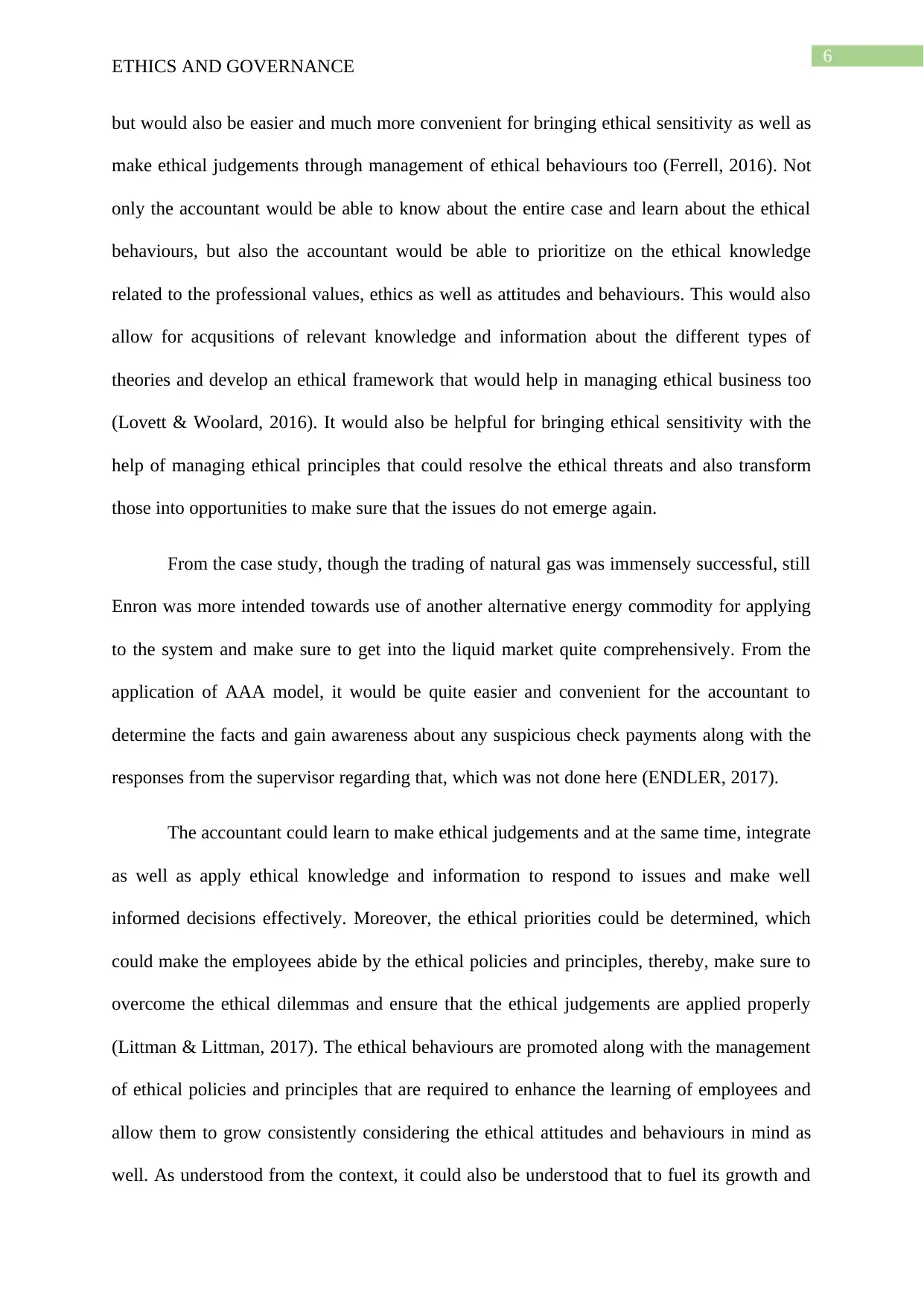
6
ETHICS AND GOVERNANCE
but would also be easier and much more convenient for bringing ethical sensitivity as well as
make ethical judgements through management of ethical behaviours too (Ferrell, 2016). Not
only the accountant would be able to know about the entire case and learn about the ethical
behaviours, but also the accountant would be able to prioritize on the ethical knowledge
related to the professional values, ethics as well as attitudes and behaviours. This would also
allow for acqusitions of relevant knowledge and information about the different types of
theories and develop an ethical framework that would help in managing ethical business too
(Lovett & Woolard, 2016). It would also be helpful for bringing ethical sensitivity with the
help of managing ethical principles that could resolve the ethical threats and also transform
those into opportunities to make sure that the issues do not emerge again.
From the case study, though the trading of natural gas was immensely successful, still
Enron was more intended towards use of another alternative energy commodity for applying
to the system and make sure to get into the liquid market quite comprehensively. From the
application of AAA model, it would be quite easier and convenient for the accountant to
determine the facts and gain awareness about any suspicious check payments along with the
responses from the supervisor regarding that, which was not done here (ENDLER, 2017).
The accountant could learn to make ethical judgements and at the same time, integrate
as well as apply ethical knowledge and information to respond to issues and make well
informed decisions effectively. Moreover, the ethical priorities could be determined, which
could make the employees abide by the ethical policies and principles, thereby, make sure to
overcome the ethical dilemmas and ensure that the ethical judgements are applied properly
(Littman & Littman, 2017). The ethical behaviours are promoted along with the management
of ethical policies and principles that are required to enhance the learning of employees and
allow them to grow consistently considering the ethical attitudes and behaviours in mind as
well. As understood from the context, it could also be understood that to fuel its growth and
ETHICS AND GOVERNANCE
but would also be easier and much more convenient for bringing ethical sensitivity as well as
make ethical judgements through management of ethical behaviours too (Ferrell, 2016). Not
only the accountant would be able to know about the entire case and learn about the ethical
behaviours, but also the accountant would be able to prioritize on the ethical knowledge
related to the professional values, ethics as well as attitudes and behaviours. This would also
allow for acqusitions of relevant knowledge and information about the different types of
theories and develop an ethical framework that would help in managing ethical business too
(Lovett & Woolard, 2016). It would also be helpful for bringing ethical sensitivity with the
help of managing ethical principles that could resolve the ethical threats and also transform
those into opportunities to make sure that the issues do not emerge again.
From the case study, though the trading of natural gas was immensely successful, still
Enron was more intended towards use of another alternative energy commodity for applying
to the system and make sure to get into the liquid market quite comprehensively. From the
application of AAA model, it would be quite easier and convenient for the accountant to
determine the facts and gain awareness about any suspicious check payments along with the
responses from the supervisor regarding that, which was not done here (ENDLER, 2017).
The accountant could learn to make ethical judgements and at the same time, integrate
as well as apply ethical knowledge and information to respond to issues and make well
informed decisions effectively. Moreover, the ethical priorities could be determined, which
could make the employees abide by the ethical policies and principles, thereby, make sure to
overcome the ethical dilemmas and ensure that the ethical judgements are applied properly
(Littman & Littman, 2017). The ethical behaviours are promoted along with the management
of ethical policies and principles that are required to enhance the learning of employees and
allow them to grow consistently considering the ethical attitudes and behaviours in mind as
well. As understood from the context, it could also be understood that to fuel its growth and
Paraphrase This Document
Need a fresh take? Get an instant paraphrase of this document with our AI Paraphraser
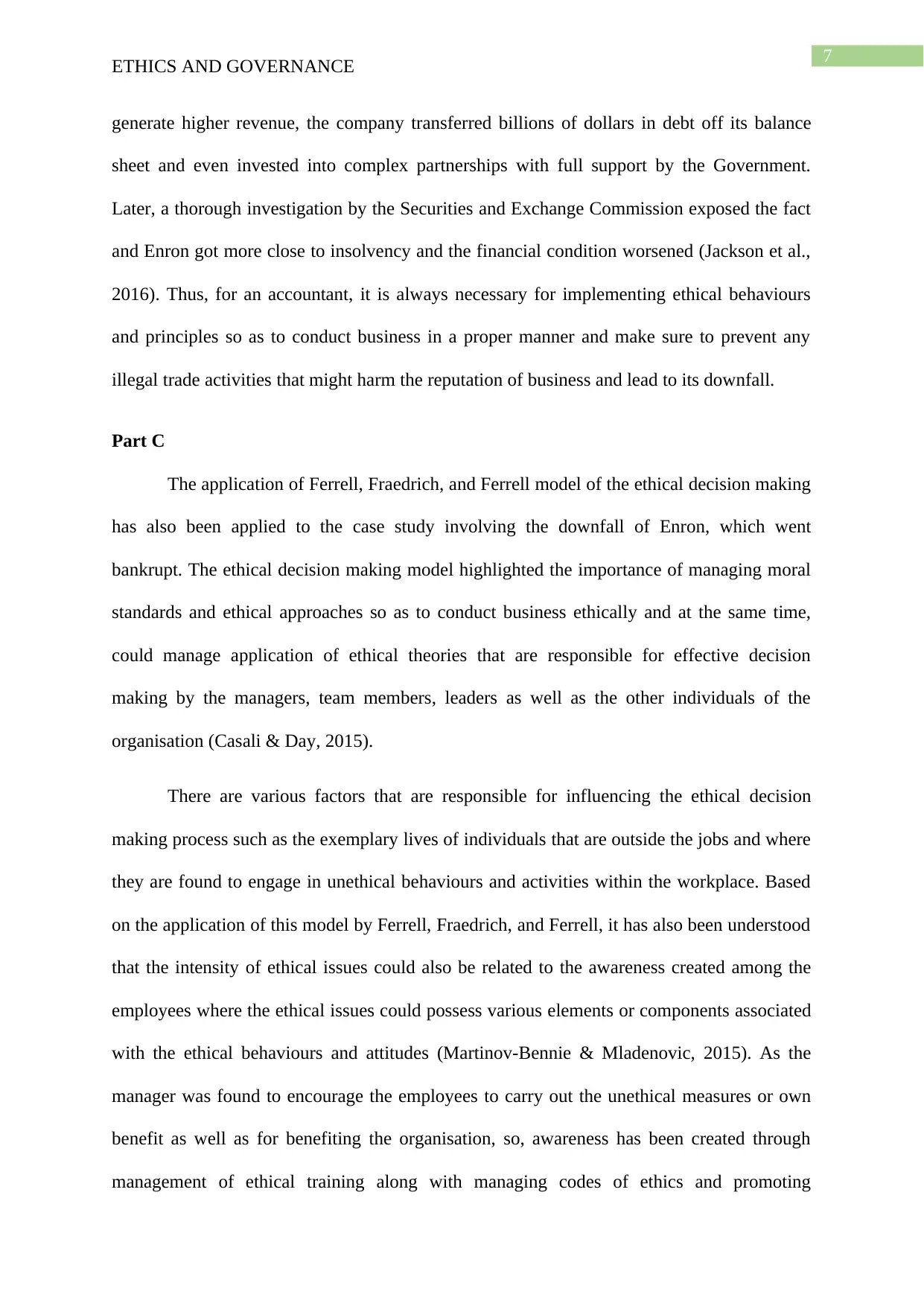
7
ETHICS AND GOVERNANCE
generate higher revenue, the company transferred billions of dollars in debt off its balance
sheet and even invested into complex partnerships with full support by the Government.
Later, a thorough investigation by the Securities and Exchange Commission exposed the fact
and Enron got more close to insolvency and the financial condition worsened (Jackson et al.,
2016). Thus, for an accountant, it is always necessary for implementing ethical behaviours
and principles so as to conduct business in a proper manner and make sure to prevent any
illegal trade activities that might harm the reputation of business and lead to its downfall.
Part C
The application of Ferrell, Fraedrich, and Ferrell model of the ethical decision making
has also been applied to the case study involving the downfall of Enron, which went
bankrupt. The ethical decision making model highlighted the importance of managing moral
standards and ethical approaches so as to conduct business ethically and at the same time,
could manage application of ethical theories that are responsible for effective decision
making by the managers, team members, leaders as well as the other individuals of the
organisation (Casali & Day, 2015).
There are various factors that are responsible for influencing the ethical decision
making process such as the exemplary lives of individuals that are outside the jobs and where
they are found to engage in unethical behaviours and activities within the workplace. Based
on the application of this model by Ferrell, Fraedrich, and Ferrell, it has also been understood
that the intensity of ethical issues could also be related to the awareness created among the
employees where the ethical issues could possess various elements or components associated
with the ethical behaviours and attitudes (Martinov-Bennie & Mladenovic, 2015). As the
manager was found to encourage the employees to carry out the unethical measures or own
benefit as well as for benefiting the organisation, so, awareness has been created through
management of ethical training along with managing codes of ethics and promoting
ETHICS AND GOVERNANCE
generate higher revenue, the company transferred billions of dollars in debt off its balance
sheet and even invested into complex partnerships with full support by the Government.
Later, a thorough investigation by the Securities and Exchange Commission exposed the fact
and Enron got more close to insolvency and the financial condition worsened (Jackson et al.,
2016). Thus, for an accountant, it is always necessary for implementing ethical behaviours
and principles so as to conduct business in a proper manner and make sure to prevent any
illegal trade activities that might harm the reputation of business and lead to its downfall.
Part C
The application of Ferrell, Fraedrich, and Ferrell model of the ethical decision making
has also been applied to the case study involving the downfall of Enron, which went
bankrupt. The ethical decision making model highlighted the importance of managing moral
standards and ethical approaches so as to conduct business ethically and at the same time,
could manage application of ethical theories that are responsible for effective decision
making by the managers, team members, leaders as well as the other individuals of the
organisation (Casali & Day, 2015).
There are various factors that are responsible for influencing the ethical decision
making process such as the exemplary lives of individuals that are outside the jobs and where
they are found to engage in unethical behaviours and activities within the workplace. Based
on the application of this model by Ferrell, Fraedrich, and Ferrell, it has also been understood
that the intensity of ethical issues could also be related to the awareness created among the
employees where the ethical issues could possess various elements or components associated
with the ethical behaviours and attitudes (Martinov-Bennie & Mladenovic, 2015). As the
manager was found to encourage the employees to carry out the unethical measures or own
benefit as well as for benefiting the organisation, so, awareness has been created through
management of ethical training along with managing codes of ethics and promoting
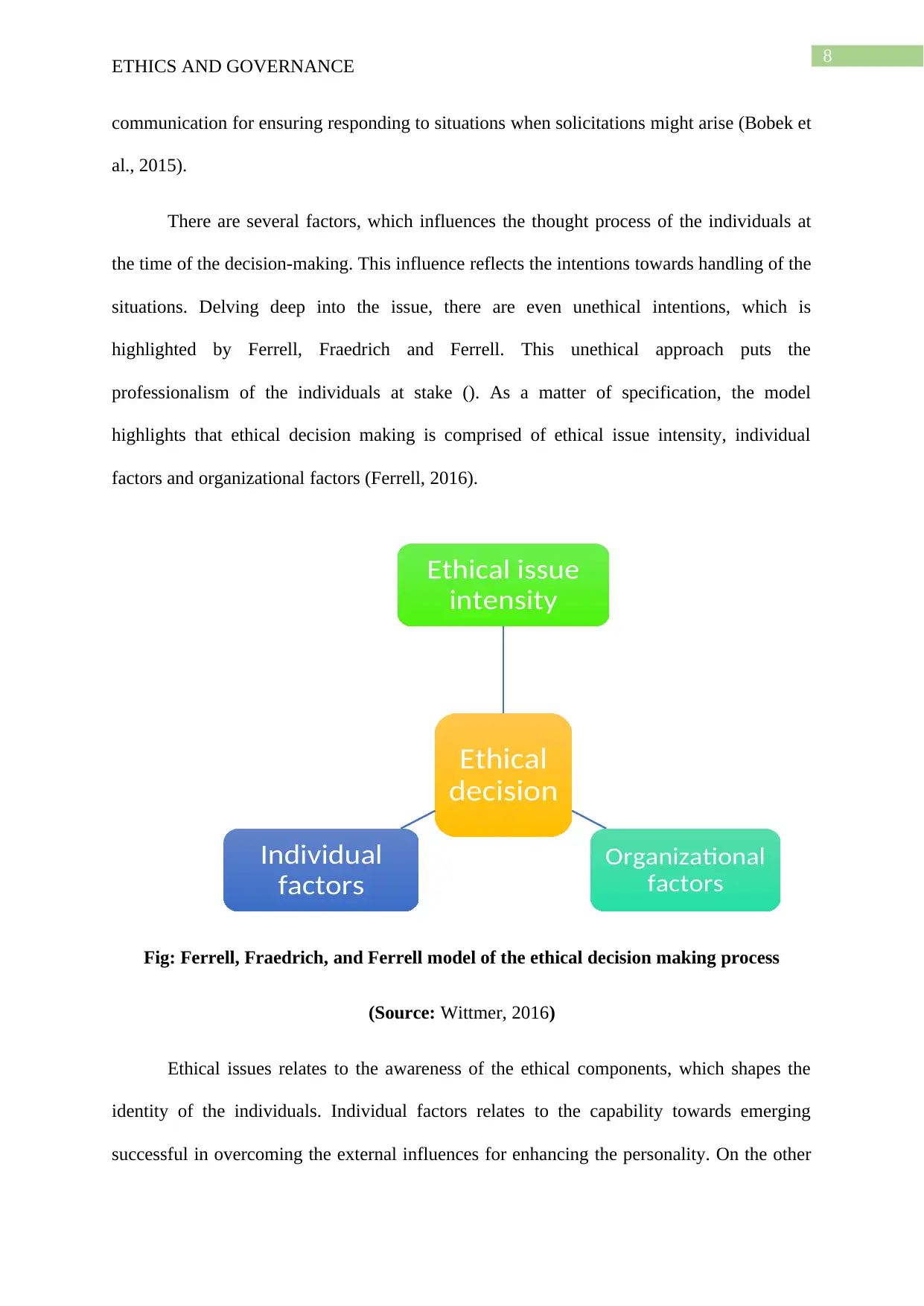
8
ETHICS AND GOVERNANCE
communication for ensuring responding to situations when solicitations might arise (Bobek et
al., 2015).
There are several factors, which influences the thought process of the individuals at
the time of the decision-making. This influence reflects the intentions towards handling of the
situations. Delving deep into the issue, there are even unethical intentions, which is
highlighted by Ferrell, Fraedrich and Ferrell. This unethical approach puts the
professionalism of the individuals at stake (). As a matter of specification, the model
highlights that ethical decision making is comprised of ethical issue intensity, individual
factors and organizational factors (Ferrell, 2016).
Fig: Ferrell, Fraedrich, and Ferrell model of the ethical decision making process
(Source: Wittmer, 2016)
Ethical issues relates to the awareness of the ethical components, which shapes the
identity of the individuals. Individual factors relates to the capability towards emerging
successful in overcoming the external influences for enhancing the personality. On the other
Ethical
decision
Ethical issue
intensity
Organizational
factors
Individual
factors
ETHICS AND GOVERNANCE
communication for ensuring responding to situations when solicitations might arise (Bobek et
al., 2015).
There are several factors, which influences the thought process of the individuals at
the time of the decision-making. This influence reflects the intentions towards handling of the
situations. Delving deep into the issue, there are even unethical intentions, which is
highlighted by Ferrell, Fraedrich and Ferrell. This unethical approach puts the
professionalism of the individuals at stake (). As a matter of specification, the model
highlights that ethical decision making is comprised of ethical issue intensity, individual
factors and organizational factors (Ferrell, 2016).
Fig: Ferrell, Fraedrich, and Ferrell model of the ethical decision making process
(Source: Wittmer, 2016)
Ethical issues relates to the awareness of the ethical components, which shapes the
identity of the individuals. Individual factors relates to the capability towards emerging
successful in overcoming the external influences for enhancing the personality. On the other
Ethical
decision
Ethical issue
intensity
Organizational
factors
Individual
factors
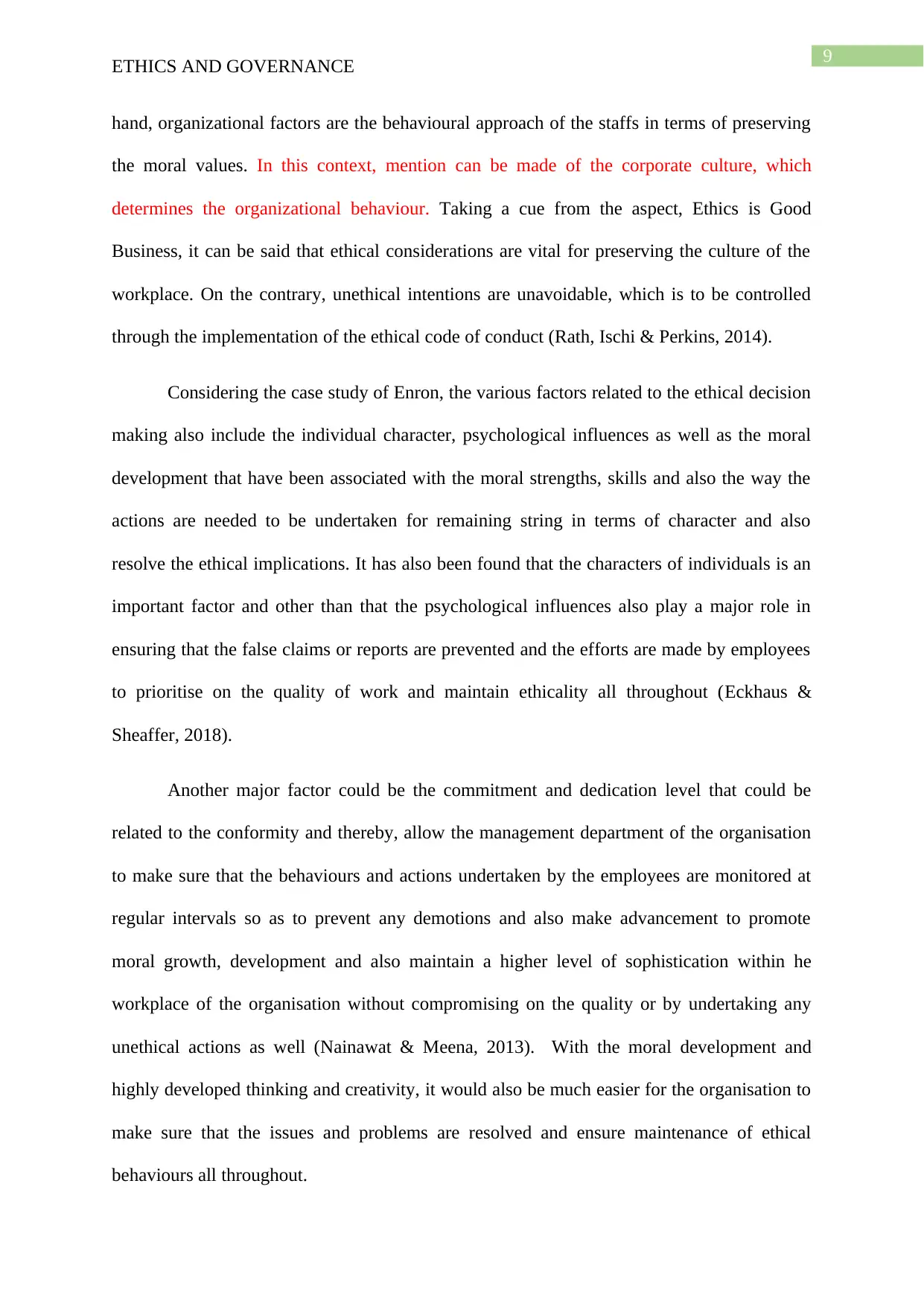
9
ETHICS AND GOVERNANCE
hand, organizational factors are the behavioural approach of the staffs in terms of preserving
the moral values. In this context, mention can be made of the corporate culture, which
determines the organizational behaviour. Taking a cue from the aspect, Ethics is Good
Business, it can be said that ethical considerations are vital for preserving the culture of the
workplace. On the contrary, unethical intentions are unavoidable, which is to be controlled
through the implementation of the ethical code of conduct (Rath, Ischi & Perkins, 2014).
Considering the case study of Enron, the various factors related to the ethical decision
making also include the individual character, psychological influences as well as the moral
development that have been associated with the moral strengths, skills and also the way the
actions are needed to be undertaken for remaining string in terms of character and also
resolve the ethical implications. It has also been found that the characters of individuals is an
important factor and other than that the psychological influences also play a major role in
ensuring that the false claims or reports are prevented and the efforts are made by employees
to prioritise on the quality of work and maintain ethicality all throughout (Eckhaus &
Sheaffer, 2018).
Another major factor could be the commitment and dedication level that could be
related to the conformity and thereby, allow the management department of the organisation
to make sure that the behaviours and actions undertaken by the employees are monitored at
regular intervals so as to prevent any demotions and also make advancement to promote
moral growth, development and also maintain a higher level of sophistication within he
workplace of the organisation without compromising on the quality or by undertaking any
unethical actions as well (Nainawat & Meena, 2013). With the moral development and
highly developed thinking and creativity, it would also be much easier for the organisation to
make sure that the issues and problems are resolved and ensure maintenance of ethical
behaviours all throughout.
ETHICS AND GOVERNANCE
hand, organizational factors are the behavioural approach of the staffs in terms of preserving
the moral values. In this context, mention can be made of the corporate culture, which
determines the organizational behaviour. Taking a cue from the aspect, Ethics is Good
Business, it can be said that ethical considerations are vital for preserving the culture of the
workplace. On the contrary, unethical intentions are unavoidable, which is to be controlled
through the implementation of the ethical code of conduct (Rath, Ischi & Perkins, 2014).
Considering the case study of Enron, the various factors related to the ethical decision
making also include the individual character, psychological influences as well as the moral
development that have been associated with the moral strengths, skills and also the way the
actions are needed to be undertaken for remaining string in terms of character and also
resolve the ethical implications. It has also been found that the characters of individuals is an
important factor and other than that the psychological influences also play a major role in
ensuring that the false claims or reports are prevented and the efforts are made by employees
to prioritise on the quality of work and maintain ethicality all throughout (Eckhaus &
Sheaffer, 2018).
Another major factor could be the commitment and dedication level that could be
related to the conformity and thereby, allow the management department of the organisation
to make sure that the behaviours and actions undertaken by the employees are monitored at
regular intervals so as to prevent any demotions and also make advancement to promote
moral growth, development and also maintain a higher level of sophistication within he
workplace of the organisation without compromising on the quality or by undertaking any
unethical actions as well (Nainawat & Meena, 2013). With the moral development and
highly developed thinking and creativity, it would also be much easier for the organisation to
make sure that the issues and problems are resolved and ensure maintenance of ethical
behaviours all throughout.
Secure Best Marks with AI Grader
Need help grading? Try our AI Grader for instant feedback on your assignments.
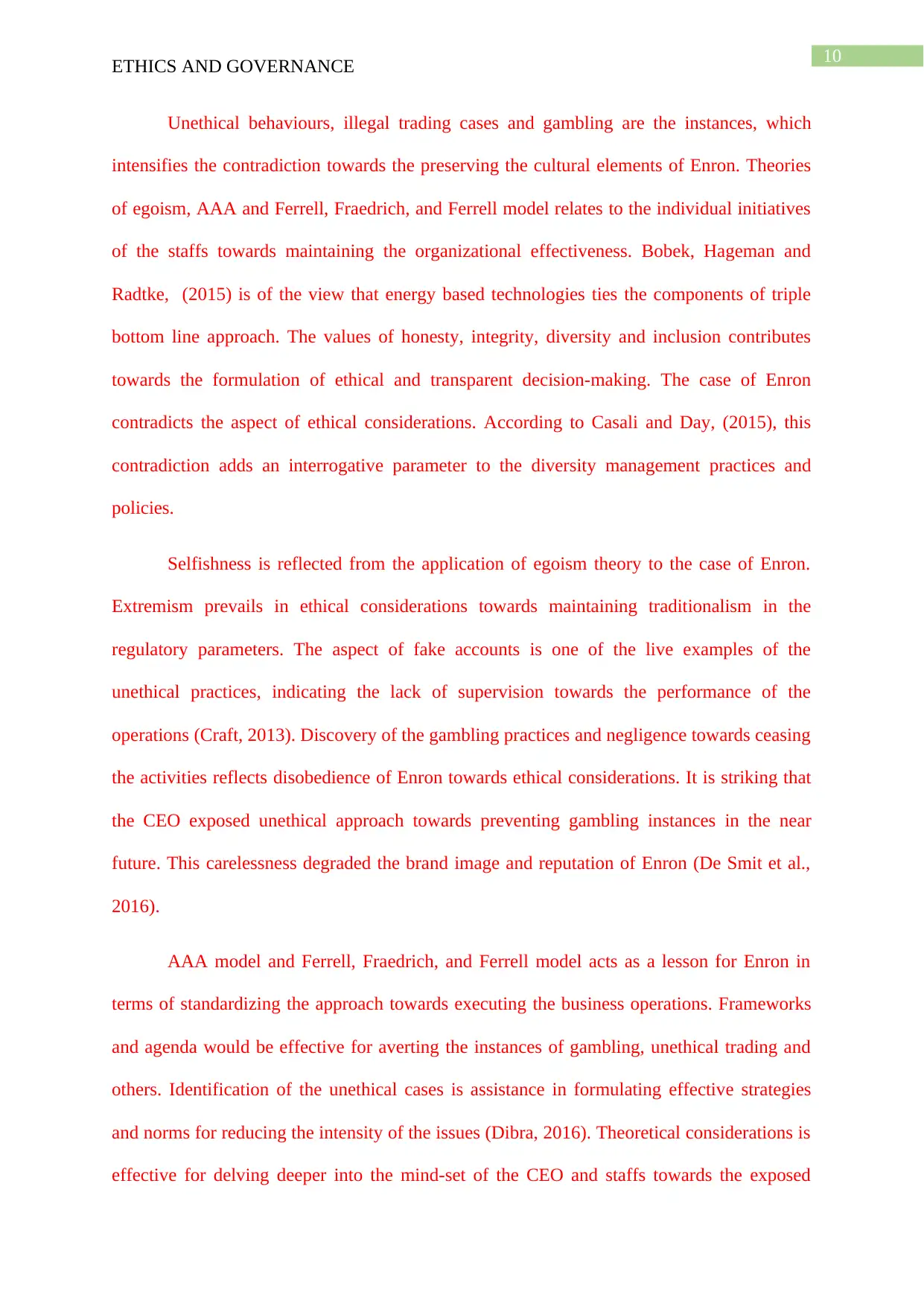
10
ETHICS AND GOVERNANCE
Unethical behaviours, illegal trading cases and gambling are the instances, which
intensifies the contradiction towards the preserving the cultural elements of Enron. Theories
of egoism, AAA and Ferrell, Fraedrich, and Ferrell model relates to the individual initiatives
of the staffs towards maintaining the organizational effectiveness. Bobek, Hageman and
Radtke, (2015) is of the view that energy based technologies ties the components of triple
bottom line approach. The values of honesty, integrity, diversity and inclusion contributes
towards the formulation of ethical and transparent decision-making. The case of Enron
contradicts the aspect of ethical considerations. According to Casali and Day, (2015), this
contradiction adds an interrogative parameter to the diversity management practices and
policies.
Selfishness is reflected from the application of egoism theory to the case of Enron.
Extremism prevails in ethical considerations towards maintaining traditionalism in the
regulatory parameters. The aspect of fake accounts is one of the live examples of the
unethical practices, indicating the lack of supervision towards the performance of the
operations (Craft, 2013). Discovery of the gambling practices and negligence towards ceasing
the activities reflects disobedience of Enron towards ethical considerations. It is striking that
the CEO exposed unethical approach towards preventing gambling instances in the near
future. This carelessness degraded the brand image and reputation of Enron (De Smit et al.,
2016).
AAA model and Ferrell, Fraedrich, and Ferrell model acts as a lesson for Enron in
terms of standardizing the approach towards executing the business operations. Frameworks
and agenda would be effective for averting the instances of gambling, unethical trading and
others. Identification of the unethical cases is assistance in formulating effective strategies
and norms for reducing the intensity of the issues (Dibra, 2016). Theoretical considerations is
effective for delving deeper into the mind-set of the CEO and staffs towards the exposed
ETHICS AND GOVERNANCE
Unethical behaviours, illegal trading cases and gambling are the instances, which
intensifies the contradiction towards the preserving the cultural elements of Enron. Theories
of egoism, AAA and Ferrell, Fraedrich, and Ferrell model relates to the individual initiatives
of the staffs towards maintaining the organizational effectiveness. Bobek, Hageman and
Radtke, (2015) is of the view that energy based technologies ties the components of triple
bottom line approach. The values of honesty, integrity, diversity and inclusion contributes
towards the formulation of ethical and transparent decision-making. The case of Enron
contradicts the aspect of ethical considerations. According to Casali and Day, (2015), this
contradiction adds an interrogative parameter to the diversity management practices and
policies.
Selfishness is reflected from the application of egoism theory to the case of Enron.
Extremism prevails in ethical considerations towards maintaining traditionalism in the
regulatory parameters. The aspect of fake accounts is one of the live examples of the
unethical practices, indicating the lack of supervision towards the performance of the
operations (Craft, 2013). Discovery of the gambling practices and negligence towards ceasing
the activities reflects disobedience of Enron towards ethical considerations. It is striking that
the CEO exposed unethical approach towards preventing gambling instances in the near
future. This carelessness degraded the brand image and reputation of Enron (De Smit et al.,
2016).
AAA model and Ferrell, Fraedrich, and Ferrell model acts as a lesson for Enron in
terms of standardizing the approach towards executing the business operations. Frameworks
and agenda would be effective for averting the instances of gambling, unethical trading and
others. Identification of the unethical cases is assistance in formulating effective strategies
and norms for reducing the intensity of the issues (Dibra, 2016). Theoretical considerations is
effective for delving deeper into the mind-set of the CEO and staffs towards the exposed
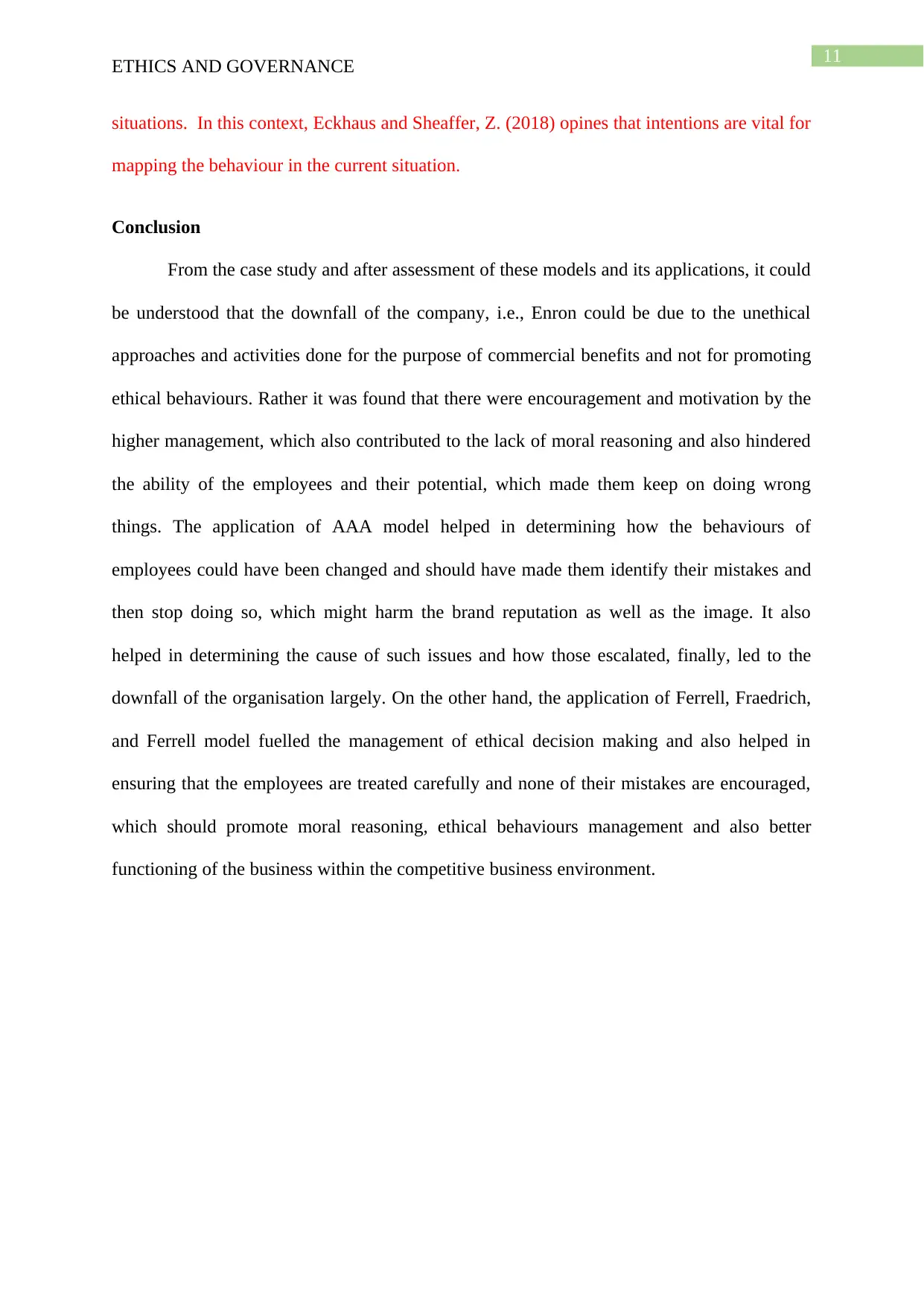
11
ETHICS AND GOVERNANCE
situations. In this context, Eckhaus and Sheaffer, Z. (2018) opines that intentions are vital for
mapping the behaviour in the current situation.
Conclusion
From the case study and after assessment of these models and its applications, it could
be understood that the downfall of the company, i.e., Enron could be due to the unethical
approaches and activities done for the purpose of commercial benefits and not for promoting
ethical behaviours. Rather it was found that there were encouragement and motivation by the
higher management, which also contributed to the lack of moral reasoning and also hindered
the ability of the employees and their potential, which made them keep on doing wrong
things. The application of AAA model helped in determining how the behaviours of
employees could have been changed and should have made them identify their mistakes and
then stop doing so, which might harm the brand reputation as well as the image. It also
helped in determining the cause of such issues and how those escalated, finally, led to the
downfall of the organisation largely. On the other hand, the application of Ferrell, Fraedrich,
and Ferrell model fuelled the management of ethical decision making and also helped in
ensuring that the employees are treated carefully and none of their mistakes are encouraged,
which should promote moral reasoning, ethical behaviours management and also better
functioning of the business within the competitive business environment.
ETHICS AND GOVERNANCE
situations. In this context, Eckhaus and Sheaffer, Z. (2018) opines that intentions are vital for
mapping the behaviour in the current situation.
Conclusion
From the case study and after assessment of these models and its applications, it could
be understood that the downfall of the company, i.e., Enron could be due to the unethical
approaches and activities done for the purpose of commercial benefits and not for promoting
ethical behaviours. Rather it was found that there were encouragement and motivation by the
higher management, which also contributed to the lack of moral reasoning and also hindered
the ability of the employees and their potential, which made them keep on doing wrong
things. The application of AAA model helped in determining how the behaviours of
employees could have been changed and should have made them identify their mistakes and
then stop doing so, which might harm the brand reputation as well as the image. It also
helped in determining the cause of such issues and how those escalated, finally, led to the
downfall of the organisation largely. On the other hand, the application of Ferrell, Fraedrich,
and Ferrell model fuelled the management of ethical decision making and also helped in
ensuring that the employees are treated carefully and none of their mistakes are encouraged,
which should promote moral reasoning, ethical behaviours management and also better
functioning of the business within the competitive business environment.
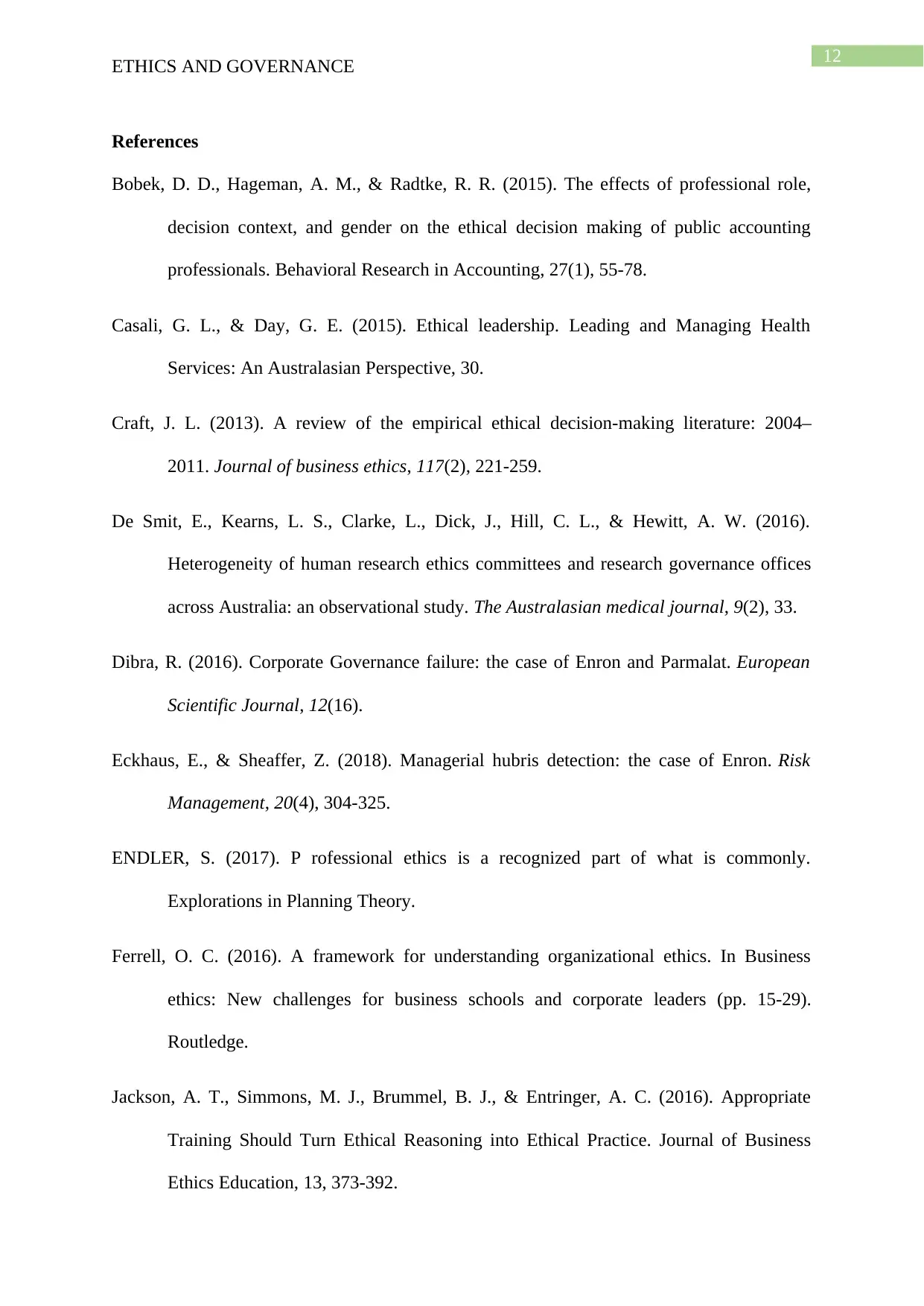
12
ETHICS AND GOVERNANCE
References
Bobek, D. D., Hageman, A. M., & Radtke, R. R. (2015). The effects of professional role,
decision context, and gender on the ethical decision making of public accounting
professionals. Behavioral Research in Accounting, 27(1), 55-78.
Casali, G. L., & Day, G. E. (2015). Ethical leadership. Leading and Managing Health
Services: An Australasian Perspective, 30.
Craft, J. L. (2013). A review of the empirical ethical decision-making literature: 2004–
2011. Journal of business ethics, 117(2), 221-259.
De Smit, E., Kearns, L. S., Clarke, L., Dick, J., Hill, C. L., & Hewitt, A. W. (2016).
Heterogeneity of human research ethics committees and research governance offices
across Australia: an observational study. The Australasian medical journal, 9(2), 33.
Dibra, R. (2016). Corporate Governance failure: the case of Enron and Parmalat. European
Scientific Journal, 12(16).
Eckhaus, E., & Sheaffer, Z. (2018). Managerial hubris detection: the case of Enron. Risk
Management, 20(4), 304-325.
ENDLER, S. (2017). P rofessional ethics is a recognized part of what is commonly.
Explorations in Planning Theory.
Ferrell, O. C. (2016). A framework for understanding organizational ethics. In Business
ethics: New challenges for business schools and corporate leaders (pp. 15-29).
Routledge.
Jackson, A. T., Simmons, M. J., Brummel, B. J., & Entringer, A. C. (2016). Appropriate
Training Should Turn Ethical Reasoning into Ethical Practice. Journal of Business
Ethics Education, 13, 373-392.
ETHICS AND GOVERNANCE
References
Bobek, D. D., Hageman, A. M., & Radtke, R. R. (2015). The effects of professional role,
decision context, and gender on the ethical decision making of public accounting
professionals. Behavioral Research in Accounting, 27(1), 55-78.
Casali, G. L., & Day, G. E. (2015). Ethical leadership. Leading and Managing Health
Services: An Australasian Perspective, 30.
Craft, J. L. (2013). A review of the empirical ethical decision-making literature: 2004–
2011. Journal of business ethics, 117(2), 221-259.
De Smit, E., Kearns, L. S., Clarke, L., Dick, J., Hill, C. L., & Hewitt, A. W. (2016).
Heterogeneity of human research ethics committees and research governance offices
across Australia: an observational study. The Australasian medical journal, 9(2), 33.
Dibra, R. (2016). Corporate Governance failure: the case of Enron and Parmalat. European
Scientific Journal, 12(16).
Eckhaus, E., & Sheaffer, Z. (2018). Managerial hubris detection: the case of Enron. Risk
Management, 20(4), 304-325.
ENDLER, S. (2017). P rofessional ethics is a recognized part of what is commonly.
Explorations in Planning Theory.
Ferrell, O. C. (2016). A framework for understanding organizational ethics. In Business
ethics: New challenges for business schools and corporate leaders (pp. 15-29).
Routledge.
Jackson, A. T., Simmons, M. J., Brummel, B. J., & Entringer, A. C. (2016). Appropriate
Training Should Turn Ethical Reasoning into Ethical Practice. Journal of Business
Ethics Education, 13, 373-392.
Paraphrase This Document
Need a fresh take? Get an instant paraphrase of this document with our AI Paraphraser
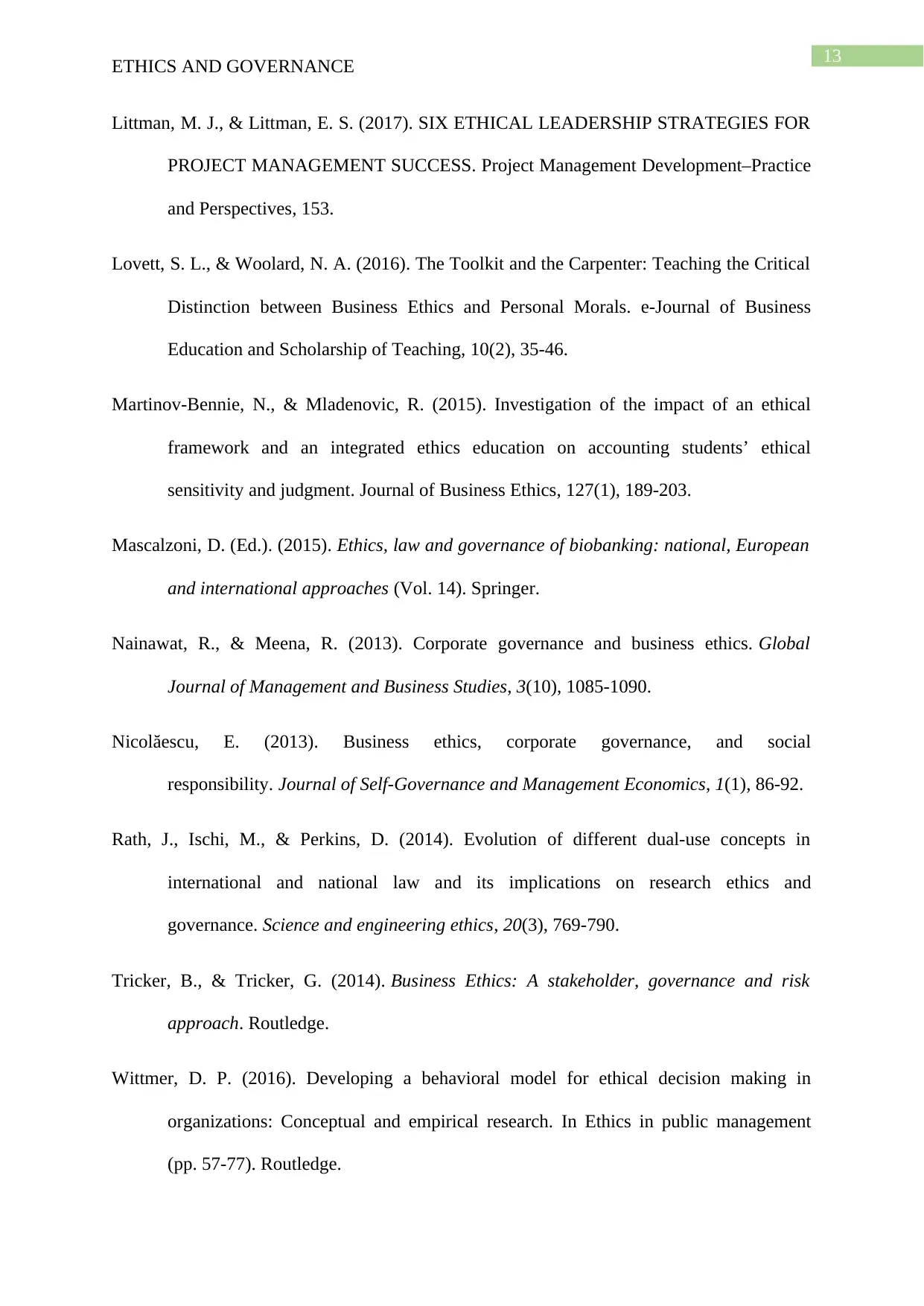
13
ETHICS AND GOVERNANCE
Littman, M. J., & Littman, E. S. (2017). SIX ETHICAL LEADERSHIP STRATEGIES FOR
PROJECT MANAGEMENT SUCCESS. Project Management Development–Practice
and Perspectives, 153.
Lovett, S. L., & Woolard, N. A. (2016). The Toolkit and the Carpenter: Teaching the Critical
Distinction between Business Ethics and Personal Morals. e-Journal of Business
Education and Scholarship of Teaching, 10(2), 35-46.
Martinov-Bennie, N., & Mladenovic, R. (2015). Investigation of the impact of an ethical
framework and an integrated ethics education on accounting students’ ethical
sensitivity and judgment. Journal of Business Ethics, 127(1), 189-203.
Mascalzoni, D. (Ed.). (2015). Ethics, law and governance of biobanking: national, European
and international approaches (Vol. 14). Springer.
Nainawat, R., & Meena, R. (2013). Corporate governance and business ethics. Global
Journal of Management and Business Studies, 3(10), 1085-1090.
Nicolăescu, E. (2013). Business ethics, corporate governance, and social
responsibility. Journal of Self-Governance and Management Economics, 1(1), 86-92.
Rath, J., Ischi, M., & Perkins, D. (2014). Evolution of different dual-use concepts in
international and national law and its implications on research ethics and
governance. Science and engineering ethics, 20(3), 769-790.
Tricker, B., & Tricker, G. (2014). Business Ethics: A stakeholder, governance and risk
approach. Routledge.
Wittmer, D. P. (2016). Developing a behavioral model for ethical decision making in
organizations: Conceptual and empirical research. In Ethics in public management
(pp. 57-77). Routledge.
ETHICS AND GOVERNANCE
Littman, M. J., & Littman, E. S. (2017). SIX ETHICAL LEADERSHIP STRATEGIES FOR
PROJECT MANAGEMENT SUCCESS. Project Management Development–Practice
and Perspectives, 153.
Lovett, S. L., & Woolard, N. A. (2016). The Toolkit and the Carpenter: Teaching the Critical
Distinction between Business Ethics and Personal Morals. e-Journal of Business
Education and Scholarship of Teaching, 10(2), 35-46.
Martinov-Bennie, N., & Mladenovic, R. (2015). Investigation of the impact of an ethical
framework and an integrated ethics education on accounting students’ ethical
sensitivity and judgment. Journal of Business Ethics, 127(1), 189-203.
Mascalzoni, D. (Ed.). (2015). Ethics, law and governance of biobanking: national, European
and international approaches (Vol. 14). Springer.
Nainawat, R., & Meena, R. (2013). Corporate governance and business ethics. Global
Journal of Management and Business Studies, 3(10), 1085-1090.
Nicolăescu, E. (2013). Business ethics, corporate governance, and social
responsibility. Journal of Self-Governance and Management Economics, 1(1), 86-92.
Rath, J., Ischi, M., & Perkins, D. (2014). Evolution of different dual-use concepts in
international and national law and its implications on research ethics and
governance. Science and engineering ethics, 20(3), 769-790.
Tricker, B., & Tricker, G. (2014). Business Ethics: A stakeholder, governance and risk
approach. Routledge.
Wittmer, D. P. (2016). Developing a behavioral model for ethical decision making in
organizations: Conceptual and empirical research. In Ethics in public management
(pp. 57-77). Routledge.
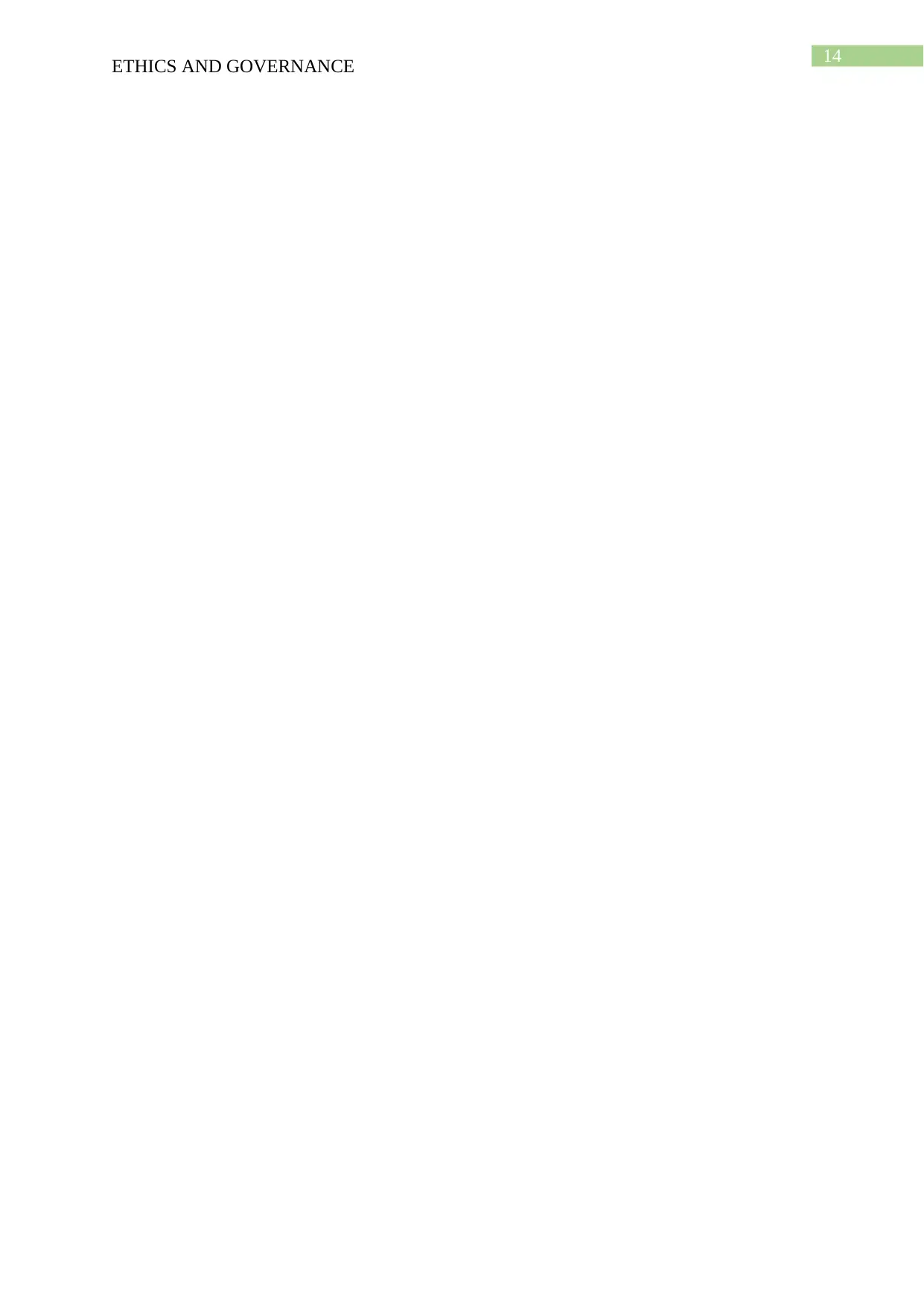
14
ETHICS AND GOVERNANCE
ETHICS AND GOVERNANCE
1 out of 15
Related Documents
Your All-in-One AI-Powered Toolkit for Academic Success.
+13062052269
info@desklib.com
Available 24*7 on WhatsApp / Email
![[object Object]](/_next/static/media/star-bottom.7253800d.svg)
Unlock your academic potential
© 2024 | Zucol Services PVT LTD | All rights reserved.





